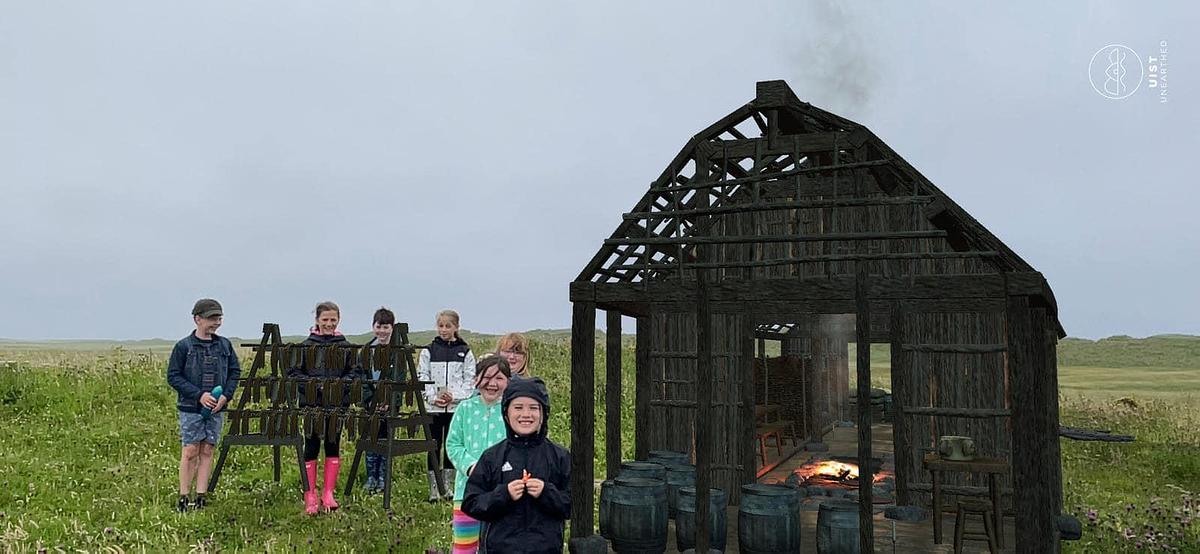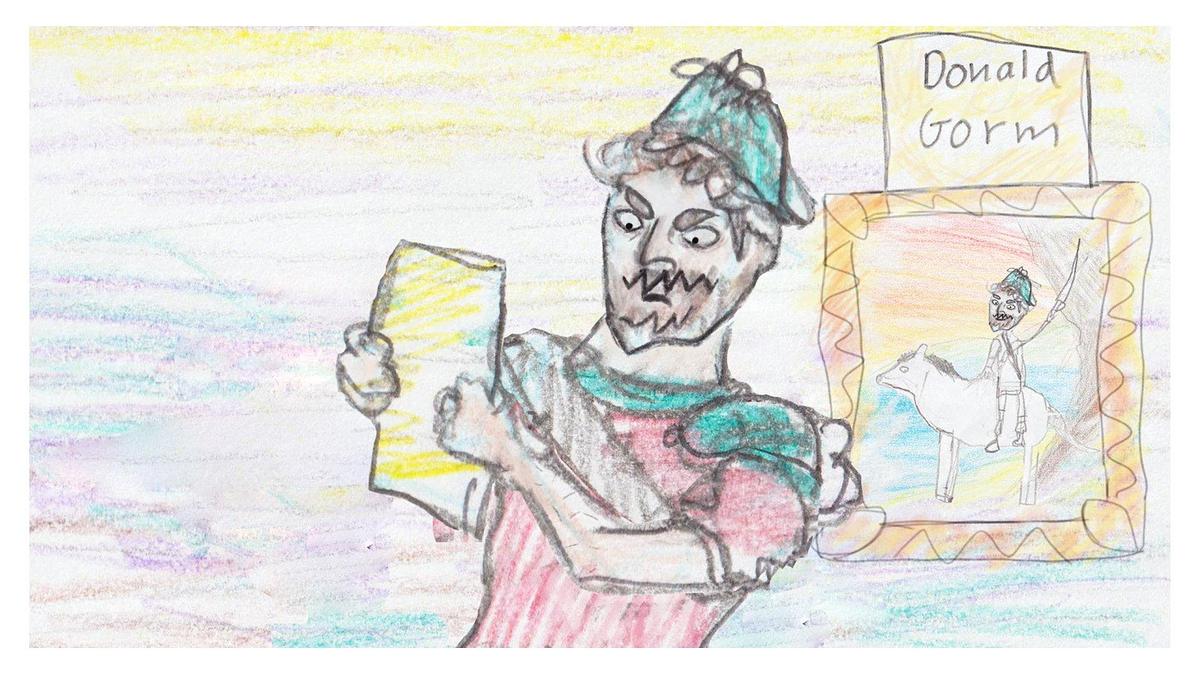_An_Solas_Òir_-_Uist_Unearthed_2.jpg)
A folk villain in Augmented Reality
This article was co-written by Liam Alastair Crouse, PhD student in collaboration with Tobar an Dualchais, and Dr Emily Gall, Project Coordinator for the Uist Virtual Archaeological Project.
National politics directly impacts local history.
The Protestant Reformation in the 16th century combined state, religion, language, and land tenure into an explosive mix. This article will explore the oral accounts of an infamous character who consolidated his power through murderous plots, and how his story has been brought to life again in a new mobile phone app.
In 1560, Scotland was declared a Protestant nation. As such, Catholic influence in the semi-autonomous Gàidhealtachd became a cause of concern for the powers in Edinburgh.
In North Uist, the MacVicars were a powerful family who held all church lands in the island. These were often the most fertile areas of machair. They were long-established lecturers at Teampall na Trianaid, the great ecclesiastic college in Càirinis, under Am Piocar Mòr, the Great Vicar.

This Catholic power was a challenge to authority of Clann Ùisdein, the branch of Clan Donald who held North Uist, Sleat and Trotternish in the Isle of Skye.
Hugh MacDonald, better recognised in Uist by his Gaelic patronym Ùisdean mac Ghilleasbaig Chlèirich, was sent to North Uist to remove Clann a’ Phiocair, the MacVicar family.
As told by School of Scottish Studies scholar Donald Archie MacDonald in Track 5067, Hugh waited until Am Piocar Mòr was off island before committing his terrible deeds. He gathered his men and attacked each of the brothers in their strongholds.
Donald Archie comments on the waulking song, “Ùisdein mhic Ghilleasbaig Chlèirich”, which was supposedly composed by a sister of the slain MacVicar brothers. This waulking song and the history it describes were popular. In addition to Track 5067, there are multiple recordings of the song, also known as “Chaidh Mis’ a dh’Eubhal Imprig”, on Tobar an Dualchais (Tracks 9811, 88636, 99697; 34667, 43582, 108954). The deep hatred for Hugh is clear in these verses, as sung by Rev William Mathieson on Track 108954:
Ùisdein mhic ’Ille Easbaig Chlèirich,
Far an laigh thu slàn nar èirich!
Do bhiodag fhéin gun robh gad reubadh
Do mhionach a bhith an lùib do lèine
Is sgeul do bhàis gu mnathan Shlèite
’S thugam-sa mo chuid fhéin e.
Hugh, son of Archibald the Clerk,
Where you lay may you not rise!
May you own dirk cut you
Leaving your entrails on your shirt
And may the women of Sleat hear of your death
And may I get my share of it.
Rev Mathieson remarked that this song was so widespread across North and South Uist that he would even hear it recited by non-singers.
It describes the murder of the MacVicar brothers by Hugh. Three of the brothers met their end in Dùn an Stìgeir, near Port nan Long, North Uist.
Dùn an Stìgeir became Hugh’s primary residence in Uist. In Track 61229, Niall a’ Ghobha MacDonald called it as Dùn a’ Chlèirich, Fort of the Clerk, after Hugh.
This popular episode of Hebridean history has been incorporated within a new mobile app called Uist Unearthed, produced by the archaeology team at UHI Outer Hebrides in partnership with Comhairle nan Eilean Siar.
The innovative app is the first of its kind, featuring Augmented Reality reconstructions of five of Uist’s most important archaeological sites, including Dùn an Stìgeir and Dùn Torcuill – two sites associated with the MacVicar brothers.
These reimagined sites will be launched in 2023, complementing three existing sites on the app – Bronze Age Cladh Hallan, Iron Age Cill Donnain, and Viking Bornais.
Dùn an Stìgeir proved the perfect site to bring archaeology together with history and folklore. The broch site, originally built during the Iron Age and renovated in mediaeval period, possesses both excellent and accessible archaeological remains and a rich and storied history, like the one above.
Unlike some of the other Bronze and Iron Age sites recreated by the project, which belong to “pre-Gaelic” Uist, Dùn an Stìgeir was inhabited during the Lordship of the Isles and acted as the setting for this popular historical legend.
It is not clear how much of Hugh MacDonald’s story is fact or fiction.
He was a real person, as Donald Archie MacDonald confirms prior to retelling Hugh’s tale on Prògram Choinnich, the daily Gaelic-language topical programme which recently concluded after 29 years.
The story of how Hugh met his end, however, might be less truthful. Unsatisfied with his new authority, he hatched a scheme to kill his half-brother, Dòmhnall Gorm Mòr, the clan chief who had sent him to usurp the MacVicar lands in the first place, and take the chieftaincy for himself.
Hugh wrote two letters: one addressed to Dòmhnall Gorm Mòr inviting him to a feast and the other to an ally who would help him to murder Dòmhnall Gorm and his men. Unfortunately for Hugh the addresses were mixed up and the letters sent to the wrong individuals.
The chieftain was furious and sent a group of clansmen to Uist under the command of Dòmhnall mac Iain ’ic Sheumais, the MacDonald hero of the battles of Carinish and the Cuillin.

Hugh hid in his stronghold at Dùn an Stìgeir but was betrayed, some say by the wife of Hector MacVicar who had lived formerly at the dùn. He was brought to Skye and thrown into the prison of Duntulm Castle, where he was given salt meat and salt water until he perished of thirst.
In the Uist Unearthed app and travelling multimedia exhibition, you can see a brilliant animation co-created by the pupils of Sgoil Uibhist a Tuath retelling the death of Hugh MacDonald, as part of the information at Dùn an Stìgeir.
You can also watch the animations online in Gaelic https://vimeo.com/712911760 and in English https://vimeo.com/712923727.
The videos, as well as the app, are a useful example of how folklore collections, such as Tobar an Dualchais, can be used within heritage projects as a rich source of oral tradition.
This is also true for Gàidhealtachd archaeology, where Gaelic folklore is so often an integral part of how we understand sites and artefacts, from Bronze-Age-burial-mounds-turned-faery-hills (sìthean) to Dùn Sgàthaich to the Crozier of St Fillan (An Coigreach).
Even when material post-dates the initial usage of sites or artefacts, folklore can be a useful key to reveal how things were subsequently (re-)interpreted. In this sense, it forms a valuable part of the archaeological context.
Projects, such as Uist Unearthed, can help reconnect folklore and archaeology and put it into the public domain in an attractive and engaging way. This colours our knowledge of how such sites were perceived in the past.
And, perhaps more importantly, such projects can help amplify Gaelic perspectives in Highland history, heritage, and archaeology.
Gaels have their own voice, and it would wrong to exclude it.
Uist Unearthed is created by archaeologists at UHI Outer Hebrides, in collaboration with Comhairle nan Eilean Siar. The project is part-funded by the European Regional Development Fund (ERDF)’s Natural and Cultural Heritage Fund administered by NatureScot, The National Lottery Heritage Fund (NLHF), Comhairle nan Eilean Siar (CnES), and Stòras Uibhist. You can follow Uist Unearthed on Instagram and Facebook: @UistUnearthed